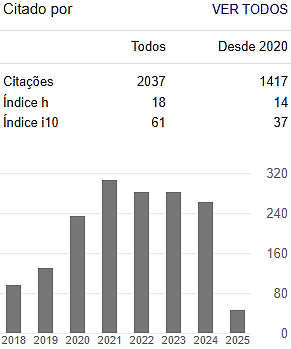QUALITY OF THE PYRENEAN AND APIRENIC FRUITS OF PITANGUEIRA (Eugenia uniflora)
Keywords:
Fruit without seed, Fruit mass, MyrtaceaeAbstract
The Surinan cherry is native fruit tree with potential of market. However, the pulp content may to be impaired by the seed fruit size. At UTFPR, there is a genotype that produces fruit without seeds that it can potentiate the use of this species in orchards, it being important to analyze the quality of its fruit produced. The objective of this study was to determine the quality of the fruits pirenics and apirenic of different Surinan cherry (E. uniflora) genotypes. In the years of 2012, 2013 and 2015, 40 mature fruits were obtained from 23 accessions of Surinan cherry, including the apirenic genotype. The fruits were taken to the Laboratory and the total fruit and seed weight, equatorial diameter of the fruit and seed, total soluble solids content (TSS) were evaluated. Genotype 23 presented physical characteristics that stand out, but the larger seed size is an undesirable factor, because with the industrialization, the pulp contend will be reduced. The genotype 19, corresponding to the Surinan cherry with apirenic fruit had the smallest diameter and weight of the seed, it being this characteristic desirable. This genotype also presented the physical-chemical characteristics considered suitable for processing or in natura market.
Downloads
References
BEZERRA, J.E.F.; SILVA JUNIOR, J. F. da; LEDERMAN, I. E. Pitanga (Eugenia uniflora L.). Jaboticabal: FUNEP, 30p. 2000. (Série Frutas Nativas, 1).
BEZERRA, J.E.F.; LEDERMAN, I.E.; SILVA JUNIOR, J.F. da.; ALVES, M.A. Comportamento da pitangueira (Eugenia uniflora L.) sob irrigação na região do Vale do Rio Moxotó, Pernambuco. Revista Brasileira de Fruticultura, v.26, n.1, p.177-179, 2004.
BRASIL. Ministério da Agricultura, Pecuária e Abastecimento. Regras para análise de sementes. Ministério da Agricultura, Pecuária e Abastecimento. Secretaria de Defesa Agropecuária. Brasília, DF: Mapa/ACS, 395p. 2009.
CHANG, S.K.; ALASALVAR, C.; SHAHIDI, F.; Review fo dried fruits: Phytochemicals, antioxidante efficacies and health benefits. Journal of Functional Foods. v. 21, p. 113-132, 2016.
COGGINS, C.W.; HIELD, H.Z. Plant growth regulators. In.:REUTHER, W.; BATCHELOR, L.D.; WEBBER, H.J. (Eds). The citrus industry. Riverside: University of California, 1968. v. 2, p. 371 – 386.
DANNER, M. A.; RASEIRA, M. do C.; SASSO, S, A. Z.; CITADIN, I.; SCARIOT, S. Repetibilidade de caracteres de fruto em araçazeiro e pitangueira. Ciência Rural, v.40, n.10, 2010.
DE ASSIS, S.A.; VELLOSA, J.C.R.; BRUNETTI, I.L.; KHALIL, N.M.; LEITE, K.M.S.C.; MARTINS, A.B.G.; OLIVEIRA, O.M.M.F. Antioxidant activity, ascorbic acid and total phenol of exotic fruits occurring in Brazil. International Journal of Food Sciences and Nutrition, v. 60, n. 5, p. 439-448, 2009.
FENNER, M. Seed ecology. London: Chapman & Hall. 1993.
FRANZON, R.C. Propagação vegetativa e modo de reprodução da pitangueira (Eugenia uniflora L.). 100 f. 2008. Tese (Doutorado em Agronomia) - Faculdade de Agronomia Eliseu Maciel, Universidade Federal de Pelotas, Pelotas, 2008.
FRUTIFATOS. Informação para a fruticultura irrigada, Brasília, v.2, n.2, 64p. 2002.
GOMES, G. C.; RODRIGUES, W. F.; GOMES, F. R. C.; BARBIERI, R. L.; GARRASTAZU, M. C. Conservação de frutíferas nativas: localização, fenologia e reprodução. Pelotas: Embrapa Clima Temperado, 36 p. 2007. (Documentos, 183).
IPA (Empresa Pernambucana de Pesquisa Agropecuária). Pitanga cultivar tropicana, 4p. 2000. (Fôlder).
LORENZI, H. Árvores do Brasil - Manual de Identificação e Cultivo de Plantas Arbóreas do Brasil. vol. 2. 2 ed. Nova Odessa : Instituto Plantarum, 2002. 384 p.
MARIN, R.; PIZZOLI, G.; LIMBERGER, R.; APEL, M.; ZUANAZZI, J.A.S.; HENRIQUES, A.T. Propriedades nutracêuticas de algumas espécies frutíferas nativas do sul do Brasil. In: RASEIRA, M.C.B.; ANTUNES, L.E.C.; TREVISAN, R.; GONÇALVES, E.D. Espécies frutíferas nativas do sul do Brasil. Pelotas: Embrapa Clima Temperado, p.107-122. 2004. (Documentos, 129)
MELO, E. A.; MACIEL, M. I. S.; LIMA, V. L. A. G.; NASCIMENTO, R. J. Capacidade antioxidante de frutas. Revista Brasileira de Ciências Farmacêuticas, v. 44, n. 2, 2008a.
MELO, E.A.; MACIEL, M.I.S.; LIMA, V.L.A.G.; ARAÚJO, C.R. Teor de fenólicos totais e capacidade antioxidante de polpas congeladas de frutas. Alim. Nutr., v.19, n.1, p. 67-72, 2008b.
MONSELISE, S.P.; GOLDSCHMIDT, E.E. Alternate bearing in fruit trees: a review.
Horticultural Reviews, v. 4, p. 128 – 173, 1982.
RASEIRA, M. do C.B.; SIMONETTO, P. R.; GRELLMAN, E; NAKASU, B. H. Lançamento de cultivares de pessegueiro, ano 2000. Embrapa Clima Temperado. 2000.
ROESLER, R.; MALTA, L.G.; CARRASCO, L.C.; HOLANDA, R.B.; SOUSA, A.S.; PASTORE, G.M. Atividade antioxidante de frutas do cerrado. Ciênc. Tecnol. Aliment., v. 27, n. 1, p. 53-60, 2007.
SHIFRISS, C.; EIDELMAN, E. An approach to parthenocarpy in peppers. Hort Science, v. 21, n. 6, p. 1458-1459, 1986.
SILVA, F. A.S.; AZEVEDO, C.A.V. Principal Components Analysis in the Software Assistat-Statistical Attendance. In: WORLD CONGRESS ON COMPUTERS IN AGRICULTURE, 7, Reno-NV-USA: American Society of Agricultural and Biological Engineers, 2009
SOARES, I.A.A.; FREITAS, F. C. L.; NEGREIROS, M. Z.; FREIRE, G.M.; AROUCHA, E. M. M.; GRANGEIRO, L. C.; LOPES, W.A.R.; DOMBROSKI, J. L. D. Interferência das plantas daninhas sobre a produtividade e qualidade de cenoura. Planta Daninha, v. 28, p. 247-254, 2010
TREVISAN, R.; TREPTOW, R.O.; GONÇALVES, E.D.; ANTUNES, L.E.C.; HERTER, F.G. Atributos de qualidade considerados pelo consumidor de Pelotas/RS na compra do pêssego in natura. Current Agricultural Science and Technology, v. 12, n.3; p. 371-374, 2006.
VILLACHICA, H.; CARVALHO, J.E.U.; MULLER, C.H.; DIAZ, S.C.; ALMANZA, M. Frutales y hortalizas promissórios de la Amazonia. Lima: Tratado de Cooperaccion Amazonica, 1996, p. 227-231. (SPT-TCA, 44).
WAGNER JÚNIOR, AMÉRICO, PALADINI, MARCOS VILLY, DANNER, MOESES ANDRIGO, MOURA, GISELY CORREA DE, GUOLLO, KARINA, & NUNES, ISADORA BISCHOFF. Aspects of the sensorial quality and nutraceuticals of Plinia cauliflora fruits. Acta Scientiarum Agronomy, v. 39, n.4, p. 475-485, 2017.
Downloads
Published
Issue
Section
License
Copyright (c) 2021 Colloquium Agrariae. ISSN: 1809-8215

This work is licensed under a Creative Commons Attribution-NonCommercial-NoDerivatives 4.0 International License.

